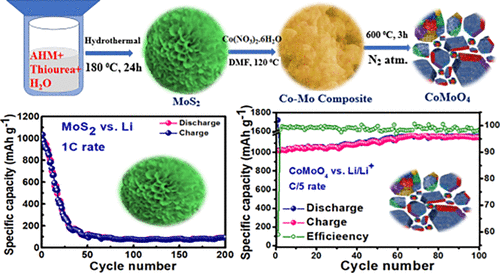当前位置:
X-MOL 学术
›
ACS Appl. Mater. Interfaces
›
论文详情
Our official English website, www.x-mol.net, welcomes your
feedback! (Note: you will need to create a separate account there.)
MoS2 Nanoflower-Derived Interconnected CoMoO4 Nanoarchitectures as a Stable and High Rate Performing Anode for Lithium-Ion Battery Applications.
ACS Applied Materials & Interfaces ( IF 8.3 ) Pub Date : 2020-02-26 , DOI: 10.1021/acsami.9b20751 Pedda Masthanaiah Ette 1, 2 , A Chithambararaj 1 , A S Prakash 1, 2 , K Ramesha 1, 2
ACS Applied Materials & Interfaces ( IF 8.3 ) Pub Date : 2020-02-26 , DOI: 10.1021/acsami.9b20751 Pedda Masthanaiah Ette 1, 2 , A Chithambararaj 1 , A S Prakash 1, 2 , K Ramesha 1, 2
Affiliation

|
In recent years, conversion-based mixed transition-metal oxides have emerged as a potential anode for the next generation lithium-ion batteries because of their high theoretical capacity and high rate performance. Herein, an interconnected cobalt molybdenum oxide (CoMoO4) nanoarchitecture derived from molybdenum sulfide (MoS2) nanoflowers is investigated as an anode for lithium-ion batteries. The interconnected CoMoO4 displayed an excellent discharge capacity of 1100 mA h g-1 over 100 cycles at a current rate of C/5. Moreover, the material exhibited an enhanced electrochemical stability, high rate performance, and delivered high discharge capacities of 600 and 220 mA h g-1, respectively, at 5 C and 10 C after 500 cycles. The excellent cycling stability and high rate performance of interconnected CoMoO4 are credited to its unique architecture and porous morphology. The above characteristics and the synergetic effect between the constituting metal ions not only provided a shorter diffusion path for the lithium-ion conduction but also improved the electronic conductivity and mechanical strength of the anode. The field-emission scanning electron microscopy analysis of the electrochemically cycled electrode revealed good structural integrity of the electrode. Further, the practical feasibility of interconnected CoMoO4 in the full cell was analyzed by integrating it with the LiNi0.8Mn0.1Co0.1O2 cathode, which demonstrated excellent cycling stability and high rate performance.
中文翻译:

MoS2纳米花衍生的互连CoMoO4纳米体系结构是锂离子电池应用中稳定,高性能的高性能阳极。
近年来,基于转换的混合过渡金属氧化物因其高理论容量和高倍率性能而成为下一代锂离子电池的潜在阳极。本文中,研究了源自硫化钼(MoS2)纳米花的互连氧化钼钴(CoMoO4)纳米体系结构作为锂离子电池的负极。互连的CoMoO4在100次循环中以C / 5的电流速率显示出1100 mA h g-1的出色放电容量。而且,该材料表现出增强的电化学稳定性,高倍率性能,并且在500次循环后在5 C和10 C时分别具有600和220 mA h g-1的高放电容量。互连的CoMoO4具有出色的循环稳定性和高速率性能,这归因于其独特的结构和多孔形态。上述特性和构成金属离子之间的协同作用不仅为锂离子传导提供了更短的扩散路径,而且还改善了阳极的电子传导性和机械强度。电化学循环电极的场发射扫描电子显微镜分析表明电极具有良好的结构完整性。此外,通过将CoMoO4与LiNi0.8Mn0.1Co0.1O2阴极集成在一起,分析了在整个电池中互连CoMoO4的实际可行性,这证明了出色的循环稳定性和高倍率性能。上述特性和构成金属离子之间的协同作用不仅为锂离子传导提供了更短的扩散路径,而且还改善了阳极的电子传导性和机械强度。电化学循环电极的场发射扫描电子显微镜分析表明电极具有良好的结构完整性。此外,通过将CoMoO4与LiNi0.8Mn0.1Co0.1O2阴极集成在一起,分析了在整个电池中互连CoMoO4的实际可行性,这证明了出色的循环稳定性和高倍率性能。上述特性和构成金属离子之间的协同作用不仅为锂离子传导提供了更短的扩散路径,而且还改善了阳极的电子传导性和机械强度。电化学循环电极的场发射扫描电子显微镜分析表明电极具有良好的结构完整性。此外,通过将CoMoO4与LiNi0.8Mn0.1Co0.1O2阴极集成在一起,分析了在整个电池中互连CoMoO4的实际可行性,这证明了出色的循环稳定性和高倍率性能。电化学循环电极的场发射扫描电子显微镜分析表明电极具有良好的结构完整性。此外,通过将CoMoO4与LiNi0.8Mn0.1Co0.1O2阴极集成在一起,分析了在整个电池中互连CoMoO4的实际可行性,这证明了出色的循环稳定性和高倍率性能。电化学循环电极的场发射扫描电子显微镜分析表明电极具有良好的结构完整性。此外,通过将CoMoO4与LiNi0.8Mn0.1Co0.1O2阴极集成在一起,分析了在整个电池中互连CoMoO4的实际可行性,这证明了出色的循环稳定性和高倍率性能。
更新日期:2020-02-26
中文翻译:

MoS2纳米花衍生的互连CoMoO4纳米体系结构是锂离子电池应用中稳定,高性能的高性能阳极。
近年来,基于转换的混合过渡金属氧化物因其高理论容量和高倍率性能而成为下一代锂离子电池的潜在阳极。本文中,研究了源自硫化钼(MoS2)纳米花的互连氧化钼钴(CoMoO4)纳米体系结构作为锂离子电池的负极。互连的CoMoO4在100次循环中以C / 5的电流速率显示出1100 mA h g-1的出色放电容量。而且,该材料表现出增强的电化学稳定性,高倍率性能,并且在500次循环后在5 C和10 C时分别具有600和220 mA h g-1的高放电容量。互连的CoMoO4具有出色的循环稳定性和高速率性能,这归因于其独特的结构和多孔形态。上述特性和构成金属离子之间的协同作用不仅为锂离子传导提供了更短的扩散路径,而且还改善了阳极的电子传导性和机械强度。电化学循环电极的场发射扫描电子显微镜分析表明电极具有良好的结构完整性。此外,通过将CoMoO4与LiNi0.8Mn0.1Co0.1O2阴极集成在一起,分析了在整个电池中互连CoMoO4的实际可行性,这证明了出色的循环稳定性和高倍率性能。上述特性和构成金属离子之间的协同作用不仅为锂离子传导提供了更短的扩散路径,而且还改善了阳极的电子传导性和机械强度。电化学循环电极的场发射扫描电子显微镜分析表明电极具有良好的结构完整性。此外,通过将CoMoO4与LiNi0.8Mn0.1Co0.1O2阴极集成在一起,分析了在整个电池中互连CoMoO4的实际可行性,这证明了出色的循环稳定性和高倍率性能。上述特性和构成金属离子之间的协同作用不仅为锂离子传导提供了更短的扩散路径,而且还改善了阳极的电子传导性和机械强度。电化学循环电极的场发射扫描电子显微镜分析表明电极具有良好的结构完整性。此外,通过将CoMoO4与LiNi0.8Mn0.1Co0.1O2阴极集成在一起,分析了在整个电池中互连CoMoO4的实际可行性,这证明了出色的循环稳定性和高倍率性能。电化学循环电极的场发射扫描电子显微镜分析表明电极具有良好的结构完整性。此外,通过将CoMoO4与LiNi0.8Mn0.1Co0.1O2阴极集成在一起,分析了在整个电池中互连CoMoO4的实际可行性,这证明了出色的循环稳定性和高倍率性能。电化学循环电极的场发射扫描电子显微镜分析表明电极具有良好的结构完整性。此外,通过将CoMoO4与LiNi0.8Mn0.1Co0.1O2阴极集成在一起,分析了在整个电池中互连CoMoO4的实际可行性,这证明了出色的循环稳定性和高倍率性能。































 京公网安备 11010802027423号
京公网安备 11010802027423号